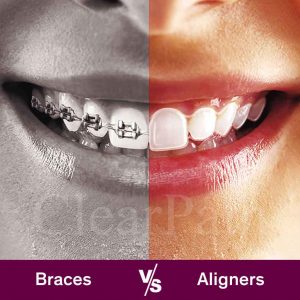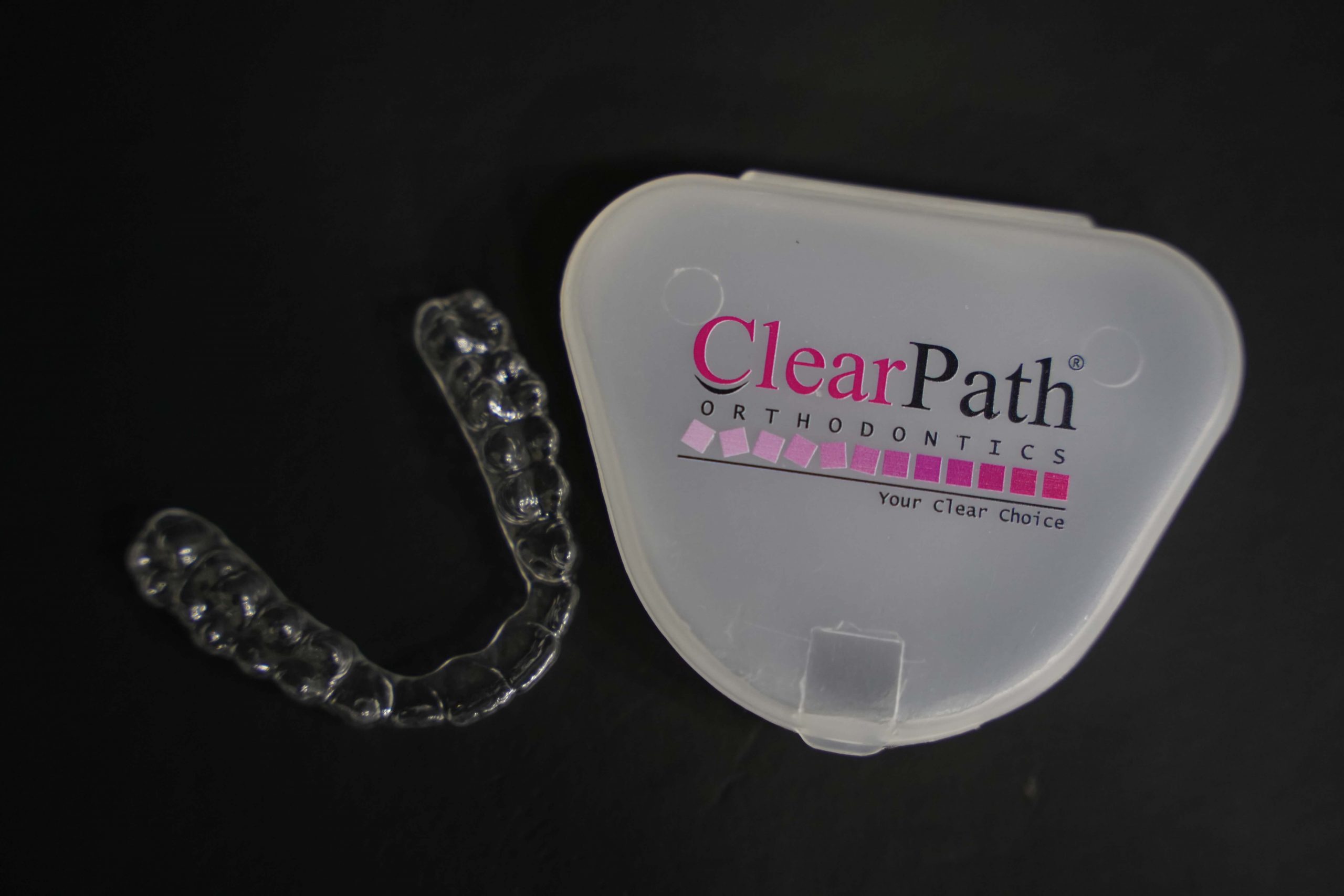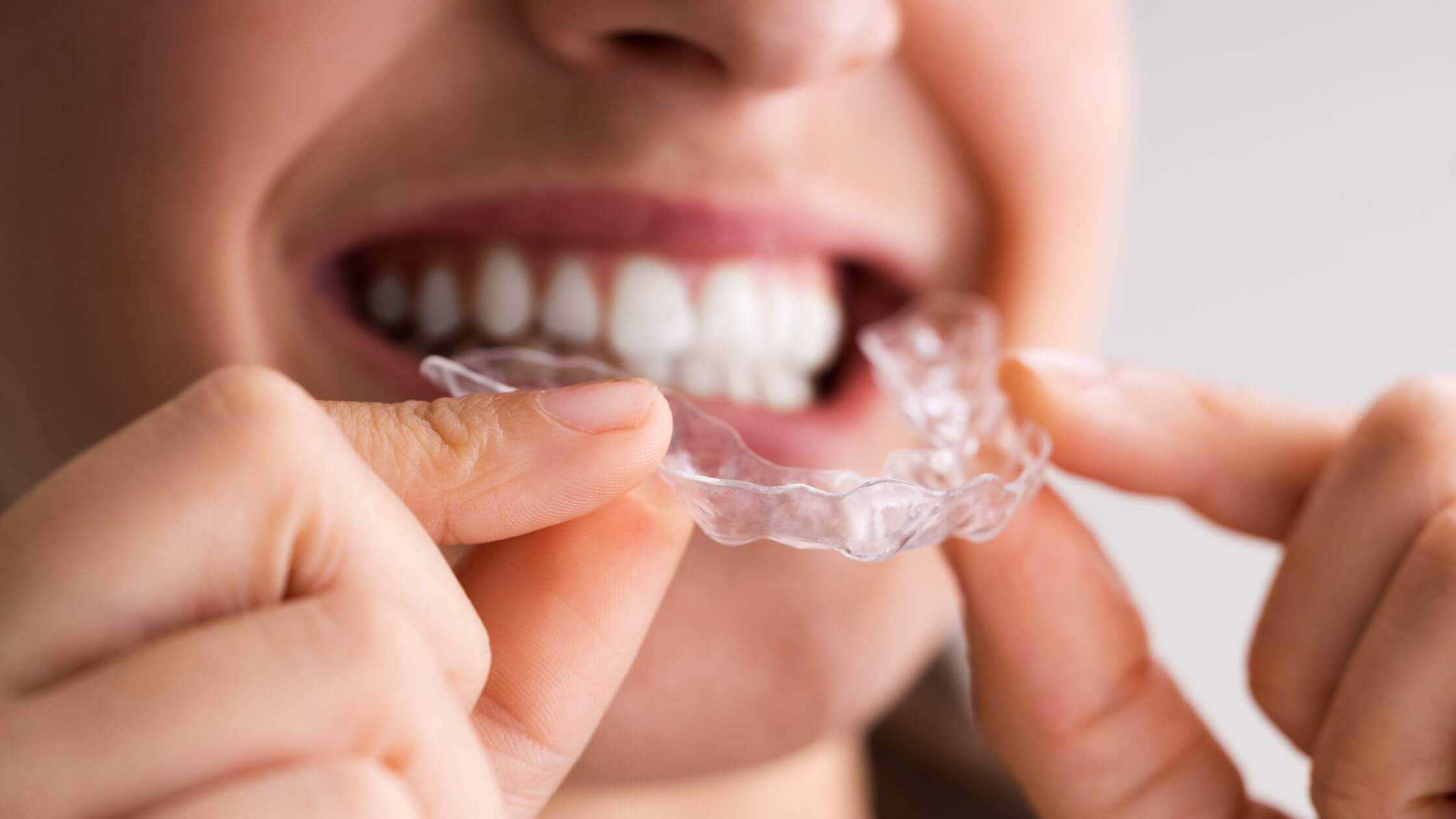Table of Contents
ToggleThe Dos and Don’ts ofMouthwash and Clear Aligners
If you are looking for a discreet and convenient way to straighten your teeth, you might have considered clear aligners.
These are transparent plastic trays that fit over your teeth and gradually move them into the desired position.
Clear aligners are becoming more popular as an alternative to traditional braces, as they offer many benefits such as being removable, comfortable, and virtually invisible.
However, wearing clear aligners also requires some adjustments to your oral hygiene routine.
You need to keep your teeth and aligners clean and free of bacteria, plaque, and food debris.
This means brushing and flossing regularly, as well as cleaning your aligners with a gentle soap or a special solution.
But what about mouthwash? Can you use mouthwash with clear aligners? Is it beneficial or harmful for your oral health and your aligner treatment?
The answer is not so simple, as there are different types of mouthwash and different opinions on their effects.
In this guide, we will explore the pros and cons of using mouthwash with clear aligners, and give you some tips on how to choose the best mouthwash for your needs.
Understanding the Concerns
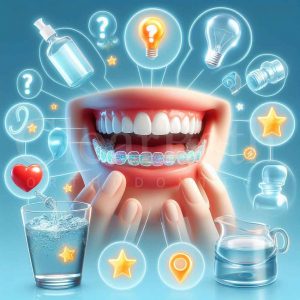
Using mouthwash with clear aligners may seem like a good idea to keep your mouth fresh and clean, but there are some potential drawbacks that you should be aware of.
Here are some of the main concerns that users have about using mouthwash with invisible braces:
| Usual Concerns with Invisible Braces | Description |
| Staining | Some mouthwashes contain artificial colors or dyes that can stain your clear aligners over time, making them less invisible and more noticeable. This can affect your confidence and satisfaction with your treatment. To avoid this, you should choose a clear or colorless mouthwash, or rinse your aligners thoroughly after using mouthwash. |
| Damage | Some mouthwashes contain alcohol or other harsh chemicals that can damage the plastic material of your clear aligners, making them brittle, warped, or cracked. This can compromise the effectiveness and comfort of your treatment, as well as increase the risk of infection or irritation. To avoid this, you should choose a gentle or alcohol-free mouthwash, or use mouthwash sparingly and only for a short duration. |
| Interference | Some mouthwashes contain fluoride or other ingredients that can interfere with the movement of your teeth by creating a thin layer or film on your enamel. This can reduce the friction and force that your clear aligners apply to your teeth, slowing down your treatment progress. To avoid this, you should choose a fluoride-free mouthwash, or use mouthwash before putting on your aligners, not after. |
These are some of the common questions that users have about using mouthwash with clear aligners.
Of course, the best way to find out the answer for your specific case is to consult your dentist or orthodontist, who can recommend the best mouthwash for your oral health and aligner treatment.
Tips on Choosing the Best Mouthwash
If you are looking for some general guidelines, here are some tips on how to choose the best mouthwash for clear aligners:
| How to Choose the Best Mouthwash | Description |
| Look for a mouthwash that is clear or colorless, gentle or alcohol-free, and fluoride-free | These are the most compatible with clear aligners, as they minimize the risk of staining, damage, or interference. |
| Use mouthwash only once or twice a day | Mouthwash should preferably be used in the morning and at night, before putting on your aligners. Do not use mouthwash more than the recommended amount or duration, as this can increase the risk of adverse effects. |
| Rinse your mouth and aligners thoroughly | Rinse with water after using mouthwash, to remove any residue or traces of the mouthwash. This will help prevent any unwanted reactions or interactions with your aligners. |
| Consider other oral hygiene options | Consider other options such as brushing, flossing, cleaning your aligners, and drinking water. These are more effective and safer ways to maintain your oral health and aligner treatment, than relying solely on mouthwash. |
You may want to use mouthwash with clear aligners, as it can help you feel more confident and comfortable with your smile.
However, you should also be aware of the potential risks and drawbacks of using mouthwash with invisible braces, and how to avoid them.
By following these tips, you can enjoy the benefits of mouthwash without compromising your clear aligner treatment.
The Good, the Bad, and the Maybe
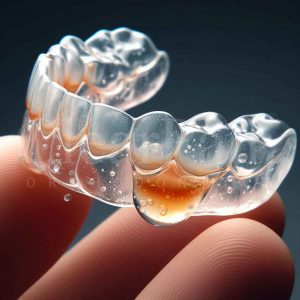
Now that you know the general concerns and tips for using mouthwash with clear aligners, you may wonder about the specific types of mouthwash and their effects.
Here are some of the common categories of mouthwash and their pros and cons for invisible braces:
Safe Use
The safest type of mouthwash to use with clear aligners is an unflavored, non-alcoholic mouthwash, with fluoride.
This type of mouthwash is gentle on your aligners and your teeth, as it does not contain any harmful or staining ingredients. It also helps prevent cavities and tooth decay, as fluoride strengthens and protects your enamel from acid erosion.
Moreover, this type of mouthwash can help you fight plaque and freshen your breath, which is important for your oral hygiene and confidence.
If you are looking for a safe and effective mouthwash to use with clear aligners, this is the one to go for.
Potential Risks
The riskiest type of mouthwash to use with clear aligners is a colored, alcohol-based whitening mouthwash.
This type of mouthwash can cause a lot of problems for your invisible braces, as it contains ingredients that can stain, damage, or interfere with your aligners and your teeth.
- Artificial colors or dyes can discolor your aligners, making them more visible and less attractive.
- The alcohol can dry out and weaken your aligners, making them more prone to cracking or breaking.
- The whitening agents can also affect your enamel, making it more sensitive or uneven, which can hinder your aligner treatment.
If you want to avoid these risks, you should steer clear of this type of mouthwash when wearing clear aligners.
Uncertainties
Some types of mouthwash have uncertain or mixed effects on clear aligners, depending on the ingredients and the usage.
These include mouthwashes that contain natural or herbal extracts, such as mint, eucalyptus, tea tree, or aloe vera.
These mouthwashes may have some benefits for your oral health, such as soothing inflammation, killing bacteria, or reducing bad breath.
However, they may also have some drawbacks for your clear aligners, such as altering the pH balance, causing allergic reactions, or leaving a residue or film on your aligners.
The effects of these mouthwashes may vary depending on the brand, the concentration, and the frequency of use.
Therefore, if you want to use these mouthwashes with clear aligners, you should do so with caution and moderation, and always consult your dentist or orthodontist before trying them.
Best Practices of Using Mouthwash with Clear Aligners
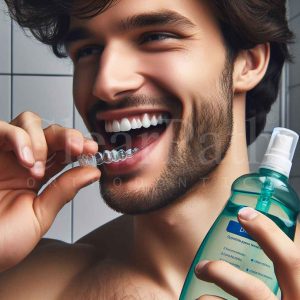
If you decide to use mouthwash with clear aligners, you should follow some best practices to ensure that you get the most out of it without harming your aligners or your teeth.
Here are some of the best practices for using mouthwash with invisible braces:
| Mouthwash with Aligners (Best Practices) | Description |
| Remove your aligners before using mouthwash | This is the most important step, as it prevents your aligners from getting exposed to the mouthwash and its ingredients. By removing your aligners, you also allow the mouthwash to reach all the areas of your mouth, especially the spaces between your teeth and under your gums, where bacteria and plaque can accumulate. You should also rinse your aligners thoroughly with water before reinserting them, to remove any saliva or debris that may have stuck to them. |
| Use mouthwash after brushing and flossing | The best time to use mouthwash with clear aligners is after you have brushed and flossed your teeth, as this ensures that your mouth is as clean as possible before putting on your aligners. Brushing and flossing remove the majority of the plaque and food particles from your teeth, while mouthwash helps to kill any remaining bacteria and freshen your breath. By using mouthwash after brushing and flossing, you also avoid rinsing away the fluoride from your toothpaste, which can help to protect your enamel and prevent cavities |
| Limit mouthwash use to 1-2 times a day | While mouthwash can be beneficial for your oral health and aligner treatment, you should not overuse it, as this can have negative consequences. Using mouthwash too often or for too long can dry out your mouth, irritate your gums, or alter the pH balance of your saliva, which can affect your oral health and aligner treatment. Therefore, you should limit your mouthwash use to 1-2 times a day, preferably in the morning and at night, and follow the instructions on the label for the amount and duration of use. |
| Choose gentle, fluoride-containing formulas | As we have discussed, not all mouthwashes are suitable for clear aligners, as some can stain, damage, or interfere with your aligners and your teeth. Therefore, you should choose a mouthwash that is gentle, alcohol-free, and fluoride-containing, as these are the most compatible with clear aligners. These mouthwashes are mild on your aligners and your teeth, as they do not contain any harmful or staining ingredients. They also help to prevent cavities and tooth decay, as fluoride strengthens your enamel and protects it from acid erosion. |
| Consider travel-friendly options | If you are traveling or on the go, you may not have access to your regular mouthwash or a sink to rinse your mouth and aligners. In that case, you can consider some travel-friendly options, such as mouthwash sprays or rinses without alcohol. These are portable and convenient alternatives to regular mouthwash, as they can fit in your purse or pocket, and do not require water to use. They can also help you keep your mouth and aligners clean and fresh, as they can kill bacteria and neutralize odors. |
However, you should still use them sparingly and moderately, as they are not a substitute for regular mouthwash or oral hygiene.
Alternative Oral Hygiene Methods
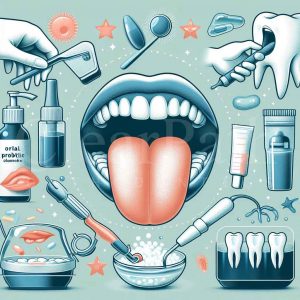
Besides using mouthwash and clear aligners, other oral hygiene methods can help you maintain fresh breath and good oral health.
Here are some of them:
Oral probiotics
These are beneficial bacteria that can improve your oral microbiome, the community of microorganisms that live in your mouth.
Oral probiotics can help prevent plaque, bad breath, oral cancer, and gum disease by competing with harmful bacteria and boosting your immune system.
You can take oral probiotics as supplements, lozenges, or drinks, or eat probiotic foods such as yogurt, cheese, or fermented vegetables.
However, you should consult your dentist before taking oral probiotics, as they may not be suitable for everyone or interact with your medications or aligners.
Tongue scraping
This is a practice of removing the debris, bacteria, and dead cells that accumulate on the surface of your tongue.
- Tongue scraping can improve your sense of taste, appearance, and health by preventing bad breath, plaque, oral cancer, and inflammation.
- You can use a tongue scraper, a small tool made of plastic or metal, or a spoon to gently scrape your tongue from back to front a few times.
- You should do this at least once a day, preferably in the morning, and rinse your mouth and scraper with water afterwards.
Water flossing
This is a device that sprays pressurized water between the gaps in your teeth and along your gum line to remove plaque and food particles.
Water flossing can be convenient and simple, but it is not as effective as regular flossing for some groups of people.
Water flossing can help people who have braces, dental implants, crowns, or difficulty using string floss, as it can reach more areas and be gentler on the teeth and gums.
You can use a water flosser once or twice a day, preferably after brushing and flossing, and adjust the pressure and angle of the water jet according to your comfort and needs.
These are some of the alternative oral hygiene methods that can complement your mouthwash and clear aligner use.
However, you should always consult your dentist for personalized recommendations based on your specific needs and treatment plan.
Your dentist can advise you on the best products, techniques, and frequency of use for your oral health and aligner treatment.
Remember, a healthy mouth is a happy mouth! 😁
Addressing Common Questions
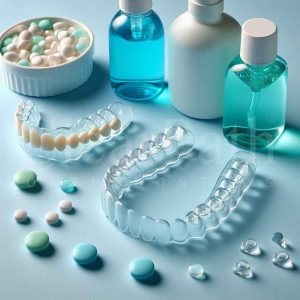
You may have some questions or doubts about using mouthwash with clear aligners, especially if you have heard conflicting or confusing information from different sources.
Here are some of the most common questions that users have about mouthwash and invisible braces, and their answers:
Can I use whitening mouthwash with my invisible braces?
The short answer is no, you should not use whitening mouthwash with clear aligners.
Whitening mouthwash contains ingredients that can stain, damage, or interfere with your aligners and your teeth, as we have discussed earlier.
Whitening mouthwash can also be ineffective or harmful for your teeth, as it can cause sensitivity, irritation, or uneven whitening.
If you want to whiten your teeth, you should consult your dentist or orthodontist for professional and safe options, such as whitening strips, gels, or trays, that are compatible with clear aligners.
My mouthwash burns with my braces, what should I do?
If your mouthwash burns or stings with your braces, you should stop using it immediately and switch to a gentler formula.
The most likely cause of the burning sensation is alcohol, which is a common ingredient in some mouthwashes.
Alcohol can dry out and irritate your mouth, as well as damage your aligners, as we have discussed earlier.
You should choose an alcohol-free mouthwash, which is milder and safer for your mouth and aligners. If the burning sensation persists or worsens, you should consult your dentist or orthodontist, as it may indicate an infection, an allergy, or a wound in your mouth.
Is mouthwash necessary with invisible braces?
The answer is no, mouthwash is not necessary with clear aligners, as long as you follow a good oral hygiene routine.
Mouthwash can be helpful for some users, as it can kill bacteria and freshen breath, but it is not a substitute for brushing and flossing, which are the most important steps for keeping your teeth and aligners clean and healthy.
You should brush and floss your teeth at least twice a day, preferably after every meal, and clean your aligners with a gentle soap or a special solution.
You should also visit your dentist or orthodontist regularly for check-ups and adjustments. These are the best ways to ensure your oral health and aligner treatment.
The Final Word
In this guide, we have discussed the pros and cons of using mouthwash with clear aligners, and how to choose the best mouthwash for your needs.
We have also addressed some common questions and concerns that users have about mouthwash and invisible braces and provided some alternative oral hygiene methods that can complement your mouthwash use.
The main takeaway is that mouthwash can be beneficial for your oral health and aligner treatment, as long as you use it safely and responsibly.
- You should always consult your dentist or orthodontist for personalized recommendations based on your specific needs and treatment plan.
- You should also follow a good oral hygiene routine, which includes brushing, flossing, and cleaning your aligners regularly.
By doing so, you can ensure that your clear aligner treatment is successful and comfortable, and that your smile is healthy and beautiful.
You can also enjoy the confidence and freshness that mouthwash can provide, without compromising your clear aligner treatment.
If you are intrigued by the prospect of straightening your teeth and beautifying your smile, consider our FDA-certified invisible braces.
They are affordable, convenient, and effective, and they can transform your smile in as little as six months.
Fill out the form below, and our friendly customer service agents will guide you on the next steps while keeping your information private. Don’t wait, start your smile journey today! 😊






